Sandbach
OS grid ref:- SJ755611
The attractive market town of Sandbach, pronounced "sand-batch", was founded in Saxon times when it was known as sand bęce, meaning sand stream or sand valley. The town is recorded in the Domesday survey of 1086. In the early thirteenth century, during the reign of King John, the land around Sandbach was owned by Richard de Sandbach. Richard was the High Sheriff of Cheshire in 1230. The manor was inherited through several families including the Leghs and the Radclyffes, before finally being purchased by a member of the Crewe family. Sandbach has been a market town since 1579 when it was granted a Royal Charter by Queen Elizabeth I.
Sandbach Scool
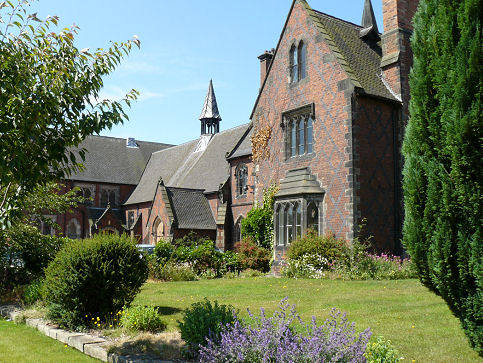
Sandbach School, situated near to the centre of the town, is a listed building and was founded in 1677. The school has occupied its present site, near the centre of Sandbach, since 1851. The site's original buildings were designed by Sir George Gilbert Scott and have been added to substantially in subsequent years.
The Sandbach Crosses
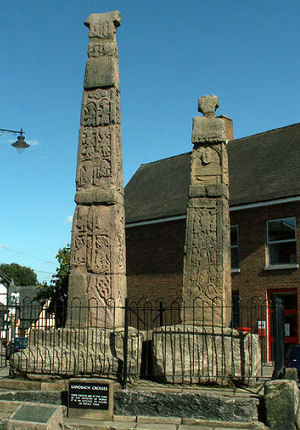
 The historic Sandbach crosses, which are scheduled ancient monuments, stand in the cobbled market square.
The historic Sandbach crosses, which are scheduled ancient monuments, stand in the cobbled market square.
The crosses are of Saxon origin and are said to date from the seventh, eighth or ninth centuries. A plaque located on the crosses states they were completed in the ninth century, It reads as follows:-
'Saxon crosses completed in the 9th century to commemorate the advent of Christianity in this Kingdom of Mercia about AD 653 in the reign of the Saxon king Penda They were restored in 1816 by Sir John Egerton after destruction by iconoclasts.'
During the seventh century, Sandbach formed part of the Anglo-Saxon tribal kingdom of Mercia. Legend relates that King Penda of Mercia arranged the marriage of his son Paeda to the Lady Alchfleda, the daughter of the Christian King Oswy of Northumbria. Penda accordingly allowed four Christian priests, Cedda, Adda, Betti and Diuma, to accompany his son on his return to Mercia. As a term of the union with his daughter, King Oswy insisted that Paeda take the Christian faith and he was baptised in the brook below the church at the bottom of The Hill.There remains doubt as to when the crosses were actually erected. There are claims that it was during the lifetime of Paeda, although others argue it was later.
They were restored in 1816 by Sir John Egerton after destruction by iconoclasts.'
The crosses are lavishly carved with animals, vine scrolls and Biblical scenes which include the Nativity of Christ and the Crucifixion. They were originally painted as well as carved, they are among the finest surviving examples of Anglo-Saxon high crosses.
. The taller cross shows biblical scenes and has a mutiliated head.
The shorter cross has a truncated shaft with the mutilated head of another cross. They were broken up by order of Parliament in the seventeenth and the fragments taken to Utkinton by Sir James Crewe where they were re-erected. They were then taken onto to Tarporley and then to Oulton Park. In 1816, they were re-were eventually restored to their present site.
The style and themes of the sculpture indicate contact with the wider Anglo-Saxon world, suggesting Sandbach was a significant centre of pre-Viking sculpture in the ninth century.
Further fragments of Anglo-Saxon cross shafts and tomb slabs, which once stood in the market place, can now be seen in the nearby churchyard of St. Mary's Church.
The red sandstone parish church of St. Mary's dates from Tudor times but was heavily restored in the reign of Queen Victoria. A church has occupied the site from as early as the Norman era. Many of Sandbach's buildings are the work of the famous architect Sir George Gilbert Scott; he designed Sandbach Literary Institution, Sandbach School, St John's Sandbach Heath and the Almshouses. He also restored St Mary's Church.
St. Mary's Church, Sandbach
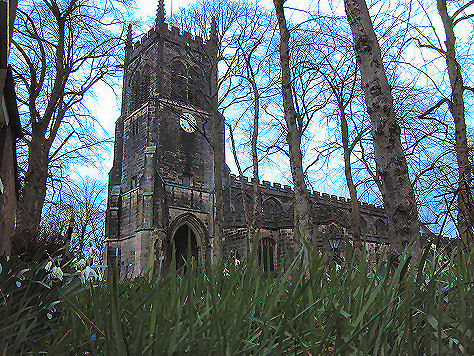
The Old Hall stands opposite St.Mary's church. Dating from 1656, it now serves as a hotel. The hall was built for Sir John Radclyffe who secured Sandbach's market charter from Queen Elizabeth I in 1579. A grade 1 listed builing, the half timbered hall has fine oak panelling on the inside. Features of particular interest are a left-handed spiral staircase and a priest hole.
Anglo-Saxon Cross fragments in the churchyard
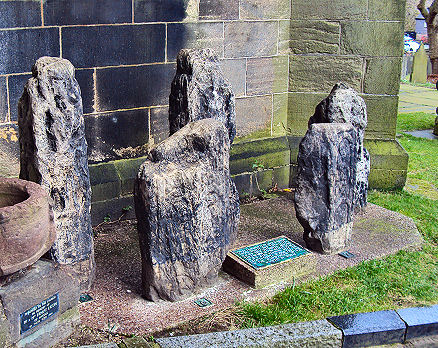
Many of Sandbach's inns, which were formerly stage coach stops, are listed buildings. The Black Bear Inn, located in the market square, was built in 1634 and was formerly owned by Lord Crewe. The inn is a handsome half timbered building which still retains its thatched roof. It is rumoured that the famous highwayman, Dick Turpin once stayed there. During the seventeenth century, the town used to be famous for its ale.
The thatched Black Bear Inn
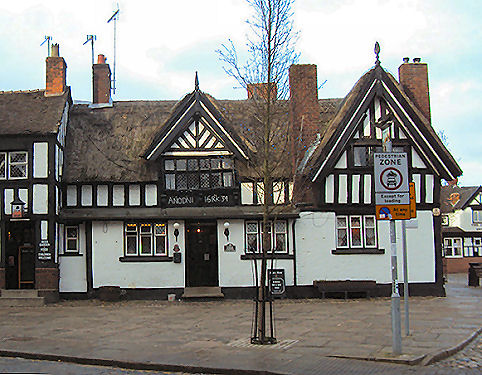
A civil war skirmish took place in the town. During the Wars of the Three Kingdoms, a Scottish army swept down through England, they were met at the Battle of Worcester before being forced into retreat. During the Sandbach Summer Fair of 3 September 1651, around 1,000 exhausted Scottish cavalry men passed through the town; under the command of David Leslie. They were promptly attacked by the townsfolkof Sandbach and the market stallholders. A contemporary newspaper stated 'The dispute was very hot for two or three houres, and there were some townsmen hurt and two or three slaine, the Townesman slew about nine or ten and tooke 100 prisoners'. As the fair and skirmish had been held on the common of the town, it thereafter came to be called Scotch Common.
Nearby places of interest
Lakemore Country Park covers over 36 acres of which ten acres are divided up into five landscaped lakes. Experience the nature trail and see the Wallabies,Llamas, Miniature Donkeys, Owls and many other unusual and rare breeds. See and feed the farm animals and visit the pets corner. The Park has both indoor and outdoor children's play areas. Children's rides and theme Crazy Golf course is also available.
Mow Cop The romantic folly was built as a summerhouse which ressembles a ruined castle in 1746 for Randle Wilbraham I of Rode Hall, and would have enhanced the view of the newly constructed Rode Hall situated some 3 miles away. The Wilbraham family used the summerhouse for picnics and entertaining friends.
Rode Hall situated at Odd Rode in Cheshire, is a red brick country house bounded by a Humphrey Repton park and lake.
Little Moreton Hall owned by the National Trust, is situated four miles south west of Congleton. The hall is a superb example of a half timbered building and dates from the late fifteenth century. Little Moreton Hall belonged to the de Moreton family, who had occupied the site since the thirteenth century.
The Bridestones, a chambered cairn, dating from the Neolithic Age, are situated in an attractive location near Congleton.
The Anglo-Saxon kingdom of Mercia
